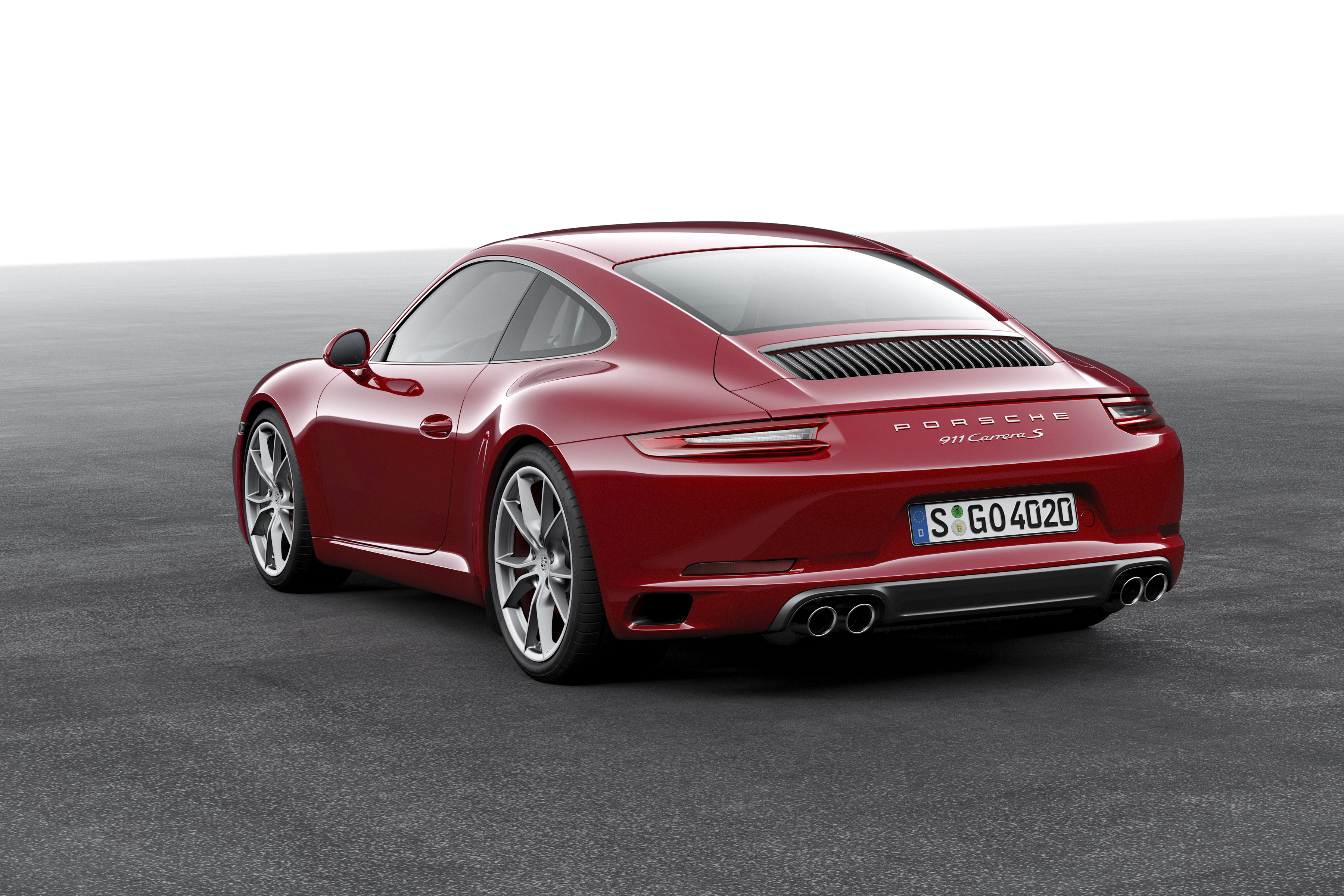
Dr. Ing. h.c. F. Porsche AG celebrates the world premiere of the new 911 Carrera at the IAA International Motor Show in Frankfurt. The new generation Porsche will unveil to the public for the first time at the press conference which will take place on the Porsche stand on September 15.
New turbocharged engines, further developed chassis and new PCM with online navigation
The technology of the new Porsche 911 Carrera
The 911 has been the world’s best-selling sports car for decades. Now the new generation has arrived to further extend this lead. With innovative turbocharged flat engines, an advanced chassis with an even greater spread between performance and comfort and a new infotainment system it is exceedingly well equipped for this.
New turbocharged engines: 20 hp power boost with lower fuel consumption
Thanks to over four decades of experience with turbocharged engines – in both motor racing and production sports cars – the new engines in the new 911 Carrera set benchmarks in performance, driving pleasure and efficiency. The completely new engine generation – which features biturbo charging and central positioning of the injector in the combustion chamber – raises the emotional driving pleasure in the 911 Carrera to an even more intensive experience: 370 hp (272 kW) of power at the rear of the 911 Carrera is waiting to be unleashed and converted into sporty propulsion. The engine of the 911 Carrera S now has a power output of 420 hp (309 kW). In both versions, power was boosted by 20 hp (15 kW). Both engines have a displacement of three litres. The greater power of the 911 Carrera S results from turbochargers with modified compressors, a model-specific exhaust system and tuned engine management.
The new Porsche engines are characterised by significantly increased torque (60 Nm in each case) with maximum torque of 450 Nm and 500 Nm, respectively, delivered constantly from a low 1,700 rpm up to 5,000 rpm for both engines – ensuring excellent driving performance. At the same time with a maximum speed of 7,500 rpm, the new engine generation clearly exceeds the top speeds of conventional turbo engines – underscored by the typical sonorous Porsche engine sound.
Every new 911 generation boasts enhanced performance and efficiency compared with the predecessor. For example, depending on the model variant, the new engine generation is almost twelve percent more efficient: fuel consumption is reduced by up to a litre per 100 kilometres. The 911 Carrera with PDK transmission now consumes just 7.4 litres of fuel per 100 kilometres (a reduction of 0.8 l per 100 km), while the 911 Carrera S with PDK consumes 7.7 l/100 km (1.0 l less per 100 km).
The new 911 also boasts impressive performance: the 911 Carrera Coupé with Porsche Doppelkupplung (PDK) and Sport Chrono Package sprints from zero to 100 km/h in 4.2 seconds – making it two tenths of a second faster than its predecessor. The 911 Carrera S with PDK and Sport Chrono Package performs its showcase discipline in just 3.9 seconds (also 0.2 s faster). This means that it is the first 911 in the Carrera family to undercut the magic four second mark. And the top speeds of both models have also increased further: the 911 Carrera now has a top speed of 295 km/h (an increase of six km/h), while the 911 Carrera S now even reaches 308 km/h (an increase of four km/h).
A standard feature: reengineered PASM chassis with 10 mm lower ride height
The 911 Carrera sets the benchmark for driving dynamics of all-round sports cars. With every new generation, Porsche is further broadening the spread between everyday comfort and race circuit performance. For the first time, the newly tuned PASM chassis (Porsche Active Suspension Management), with 10 mm lower ride height, is a standard feature on board all Carrera models. It further improves stability during fast cornering. At the same time, the new shock absorber generation with its wider spread damper rating enhance comfort thanks to an even more precise response characteristic and also improve the body connection during dynamic driving. New standard wheels with five slim twin spokes carry tyres with reduced rolling resistance and enhanced performance. Furthermore, on all variants the width of the rear rims has increased by 0.5 to 11.5 inches and the rear tyres of the 911 Carrera S now measure 305 instead of 295 millimetres.
The active rear-axle steering that is available as an option for the 911 Carrera S is chassis technology adopted from the 911 Turbo and 911 GT3. It further enhances the turn-in agility of the 911. In addition, it makes for excellent driving stability when changing lanes at high speeds. At the same time, it impresses with easier handling in city driving. For unlimited everyday practicality, Porsche offers a hydraulic lift system with integrated lifting cylinders in the struts of the front axle. At the push of a button, the ground clearance at the front can be increased by 40 millimetres within 5 seconds, thus preventing the vehicle underbody from hitting the ground, such as on steep garage exits.
New Porsche Communication Management with online navigation
A standard feature of the new 911 Carrera models is the newly developed Porsche Communication Management System (PCM) with a seven-inch multi-touch screen and voice control. Users can operate the PCM with multi-touch gestures, similar to those used for smartphones. User inputs by handwriting are possible, for instance. Mobile phones and smartphones can now also be connected via Wi-Fi. The smartphone storage surface being integrated for the first time also offers battery-saving charging and optimised mobile phone reception. Also new is the option of connecting an iPhone to the PCM to use Apple CarPlay.
Real-time traffic information is available for significantly improved navigation. It gives the driver a quick overview of the traffic situation and guarantees dynamic adaptation of the route to this information. Google Earth and Google Street View are also being integrated for the first time to offer better orientation. Other components of the PCM are Porsche Car Connect and the Porsche Connect app, which can be used for such functions as remote control of vehicle functions, transfer of destinations to the PCM for navigation and use of music streaming services by third-party providers via the PCM.
New generation of 911 Carrera engines
Higher performance and better fuel economy by forced induction
Superior power even from low revs, spontaneous power development up into the highest rev ranges and yet significantly better fuel economy: that is how the brand new generation of engines for the new 911 Carrera noticeably increases driving pleasure. 370 hp (272 kW) of power at the rear of the 911 Carrera is waiting to be unleashed and converted into sporty propulsion. The engine of the 911 Carrera S has a power output of 420 hp (309 kW). Both engines have gained 20 hp (15 kW) of power. The torque gains are even more impressive: With 450 Nm in the 911 Carrera and 500 Nm in the 911 Carrera S, the maximum torques of both engines have increased by 60 Nm. Meanwhile, the driver not only benefits from the boosted maximum torque figures; the full torque is already available from 1,700 rpm to be converted into sprinting power. The maximum torque is available over the entire range up to 5,000 rpm. At the same time, the new generation of engines is significantly more fuel-efficient. Fuel consumption has been reduced by up to one litre per 100 km, depending on the version. The 911 Carrera with PDK transmission now consumes just 7.4 litres of fuel per 100 km (0.8 l less per 100 km), while the 911 Carrera S with PDK consumes 7.7 l/100 km
(1.0 l less per 100 km).
911 Carrera S: more power by innovative turbo technology
The new generation of six-cylinder flat engines owes its significantly extended spread between performance and fuel efficiency to an ingenious bundle of technical advances. For the first time, Porsche is also implementing biturbo charging in the 911 Carrera engines, continuing a success story that began in 1974 with the market launch of the top 911 Turbo model. The technology, which was developed in motorsport and led to numerous victories there, has since been implemented in all top Porsche models, and enabled each generation to reach new record figures for power and fuel economy. One advantage of the turbo-charged engine concept lies in its higher specific power. This makes it possible to achieve the same power as a naturally aspirated engine with less engine displacement. Therefore, Porsche reduced engine displacement to three litres in both new 911 Carrera models. The greater power of the 911 Carrera S results from turbochargers with modified compressors, a model-specific exhaust system and specially tuned engine management. Both power versions reach their nominal power at 6,500 rpm, and the usable speed range extends to 7,500 rpm. These are the characteristic data of exceptionally free-revving sports car engines.
Forced induction requires an entirely new airflow system at the rear of the 911 Carrera – both for the combustion air and for intercooling. The engine gets its combustion air centrally in front of the rear spoiler. From two lateral ports on the air filter box, the airflow reaches two induction channels to the lower-mounted turbochargers. The air that is compressed and thereby heated by the turbochargers then flows through two intercoolers located laterally behind the wheel arches and then into the engine’s induction manifold via the throttle flap. Two other ducts guide the air for cooling the heated combustion air -also from the air screen
in the rear lid – to the intercoolers.
New cylinder head with central injector and variable exhaust camshaft
In-depth modifications to the base engine further increase the six-cylinder engine’s spread between sporty power capability and exemplary efficiency. The new central position of the injector improves combustion, which has direct effects on fuel economy and emissions quality. Two fuel pumps – one per cylinder bank – supply the petrol direct-injection unit with a system pressure of up to 250 bar. Moreover, an adjustable exhaust camshaft makes it possible to control the charge exchange process even more precisely. On the intake side, Porsche continues to use the proven VarioCam Plus, which variably adjusts both valve lift and valve opening duration. Another advantage of the dual-side, adaptive, reduced friction valve train: it offers even finer adjustment of the turbocharged engine to the spontaneous response at low revs that is typical for Porsche.
By implementing a new cylinder wall coating process, in which a plasma beam coats the cylinder surface with iron, engineers reduced friction and thereby the consumption of fuel and oil. Traditionally, lightweight design also plays a central role in the design of the engine. As a result, the detailed lightweight design reduced the weight of the aluminium crankcase by 1.5 kg, and the new polymer oil pan is even two kilograms lighter than in the previous generation engines.
Efficiency gains: water pump and air conditioning compressor can be completely deactivated
Auxiliary components also contribute to increased efficiency. The water pump now has a clutch that is controlled by the thermal management and can remain disengaged at low coolant temperatures. The deactivated pump no longer draws any engine power, and the coolant just circulates slowly. On the one hand, this reduces friction, and on the other, the engine reaches its operating temperature more quickly. The same applies to the air conditioning compressor. While previously its throughput could be controlled, now it can also be completely deactivated via a clutch.
New gear ratios for manual transmission that has two-disc clutch for first time
The 911 Carrera traditionally stands for unadulterated sporty driving pleasure, but with a high level of shifting comfort. Therefore, Porsche developed a two-disc clutch for the new generation of engines. It enables comfortable actuation forces despite the high torques of the new turbocharged engines that are being transmitted. This lets the driver experience the dynamism of the sports car, such as on mountain roads with lots of bends or on circuit race tracks without the shifting pleasure being spoiled by strenuous clutch work. The gear ratios were adapted to the modified engine characteristic. The longer gear ratios starting with third gear make it possible to achieve low fuel consumption figures without affecting the car’s sportiness. In addition, the mechanical design of the manual transmission was adapted to the higher torques of the engines.
PDK has new operating logic and dual-mass flywheel
The top priority in further development of the PDK was on greater efficiency while maintaining a high level of sporty and comfort properties. For the driver this is most apparent in the new shifting direction of the selector lever. As in the 911 GT3 and many Porsche race vehicles, pulling the lever back now means upshifting, while pressing it forward downshifts. For the first time, Porsche is using a dual-mass flywheel with a centrifugal pendulum in conjunction with the PDK, as well as intelligent overrun cut-off and virtual gears. The centrifugal pendulum, which incidentally is also used with the manual transmission, is an adaptive vibration absorber that dampens vibrations in the drivetrain over a broad range of engine speeds. The effect: when driving slowly, the driver can drive in a higher gear with low revs without any jolts. This enhances drive comfort and also saves on fuel.
Better fuel economy: intelligent overrun cut-off and extended automatic stop-start system
Intelligent overrun cut-off occurs in such situations as when the driver takes the foot off the accelerator pedal on a motorway descent. First, the drive control system switches to what is referred to as a coasting mode with open clutches and the engine idling. If the car’s speed still increases, intelligent overrun cut-off is activated which engages the clutch and shuts off the engine. The automatic stop-start system has also learned to interrupt the flow of fuel early when rolling to a stop. The new functions lead to further improved fuel economy automatically and without the driver noticing changes in the car’s handling.
The virtual intermediate gears have the same fuel-saving effect. They have already proven themselves in the 911 Turbo. They are used to reduce revs during quieter modes of driving, if shifting to the next higher gear would drop revs below the engines lower rev limit. To do this, the transmission controller engages adjacent gear levels, controls both clutches for defined slip and transmits the drive power in this way. When the driver accelerates, the dual clutch gearbox downshifts to the suitable gear with lightning speed. Since the PDK has oil bath clutches, this innovative transmission function is wear-free.
From the 918 Spyder: mode switch on steering wheel for Sport Chrono Package
In conjunction with the optional Sport Chrono Package, the 911 Carrera now has a mode switch on the steering wheel for the first time, derived from the hybrid mode switch of the 918 Spyder. The mode switch consists of a ring that can be turned to four 90-degree positions for the driving modes “Normal”, “Sport”, “Sport Plus” and “Individual”. Depending on the equipment, the latter setting enables drivers to configure their own individual vehicle set-up, e.g. of the PASM, active engine mounts, PDK shifting strategy and sports exhaust system. An LED integrated in the rotary switch shows the currently selected mode. The sports cars with the dual clutch gearbox also adopt the central pushbutton switch from the 918 Spyder, which the driver can use to precondition the drive and chassis control systems for enhanced performance and even faster response – e.g. during overtaking manoeuvres. The engine and PDK transmission parameters are pre-set for a period of 20 seconds to achieve the best possible acceleration. An indicator in the cockpit informs the driver of the enhanced sprinting readiness and how much longer it will last.
This is how a sports car should sound: passionate sound inside and out
The new 911 Carrera models have not only made gains in power and efficiency. Forced induction also makes the sound characteristic of the engine and exhaust system more varied, both outside and inside the car. A sound duct – which is individually tuned for each model version – transmits the induction sound into the interior. The transition from naturally aspirated operation during idle to charging with building revs extends the fullness of engine sound impressively. The exhaust systems deliver the matching sound. The 911 Carrera has a main silencer with two oval tailpipes. The S model additionally has two integrated exhaust flaps and dual tailpipes. The new sport exhaust system (also switched) is available as an option. Its characteristic elements are two round dual tailpipes that for the first time are centrally located, and of course an incomparably sporty sound. By the way, this sound is not digitally modified, and it also enables a very quiet and discreet driving style for relaxed cruising.
The chassis of the new 911 Carrera
Lower, faster, more comfortable – and also available with rear axle steering
The 911 Carrera is the original all-round sports car, and for over five decades, it has been the reference for driving dynamics. With each new generation, Porsche further increases the spread between everyday comfort and circuit performance. This generation is no exception. The new standard chassis – with its ten millimetre lower ride height and PASM (Porsche Adaptive Suspension Management) – lowers the centre of gravity for even better cornering stability, and the further developed adaptive dampers provide even more sensitive control. The agility and stability benefits realized by active rear axle steering – now being offered as an option for the first time in the 911 Carrera S – are significant. At the same time, it improves handling by reducing the turning circle. This innovative technology has already proven itself in the current 911 Turbo and 911 GT3 models. Porsche is also further enhancing the active safety of this classic sports car by offering the automatic post-collision braking system as standard.
Despite being considerably more comfortable than the previous model, the handling of the new 911 Carrera reaches a higher level of sportiness. Thanks to a new generation of active PASM dampers with broader characteristic spreads, the body connection is further improved during dynamic driving, as is the responsiveness on uneven road surfaces. Rebound buffer springs at all four wheel suspensions not only reduce the tendency to roll and pitch, especially during sporty driving, but also improve rebound response. The new chassis tuning also encompasses modified main springs and anti-roll bars. The width of the rear tyres was increased by half an inch to 11.5 inches. Together with the tyre industry, Porsche has developed a new generation of tyres for the 911 Carrera that exhibits much better performance in dry handling and braking as well as optimised wet driving properties. A sport chassis is available as an option; it lowers the ride height by ten millimetres compared to the new standard chassis, yet also offers significantly better comfort due to its new tuning.
Optional rear axle steering enhances cornering dynamics
When equipped with the optional active rear axle steering, the 911 Carrera S takes a big step closer to the excellent cornering dynamics of the 911 Turbo and the 911 GT3. The 911 shows significant improvements in agility in tight bends, in stability in high-speed lane changes and in manoeuvrability in city traffic. If the driver turns into a bend at speeds under 50 km/h, the front and rear wheels turn in opposite directions. This leads to what is known as virtual wheelbase shortening. The sports car can be guided through the bend effortlessly with smaller steering wheel inputs. The 911 with rear axle steering feels like a compact car when manoeuvring. Its turning circle is reduced by 0.5 metre to 10.7 metres. The approach is different for fast lane-changes at high speed. Starting at around 80 km/h, the front and rear wheels are turned in the same direction, giving the feeling that the sports car has a longer wheelbase. For the driver this means greater stability and more spontaneous and harmonious initiation of a change in direction due to the faster build-up of lateral forces at the rear axle.
The active rear-wheel steering comprises two electro-mechanical actuators on the left and right sides of the rear axle instead of the conventional control arms. These allow the steering angle of the rear wheels to be varied by up to around two degrees, depending on vehicle speed. By comparison, a steering angle of two degrees at the front wheels is comparable to turning the steering wheel 32 degrees from the centre position. The high lateral force potential of the steered rear axle made it possible to modify front axle steering to be
ten percent more direct, which noticeably enhances agility even more.
Automatic post-collision braking system reduces severity of accidents
The automatic post-collision braking system is being used in a Porsche sports car for the first time in the new 911 Carrera. The system can reduce the severity of a secondary collision by automatically braking the vehicle after the initial collision. The automatic post-collision braking system is triggered when the airbag sensors detect a collision of a specific severity. Then the system autonomously initiates braking at a maximum deceleration rate of 0.6 g. The driver can override the post-collision braking system at any time. Its functionality is deactivated when the driver presses the accelerator pedal, for instance. It is also deactivated if the driver initiates hard braking at an even higher rate of deceleration. The assistance system generally applies the brakes until a residual vehicle speed of ten km/h is reached.
New steering wheels and optional lift system for front axle
The improved handling is transmitted to the driver via the new generation steering wheel whose design is based on the steering wheel of the 918 Spyder. The basic steering wheel has a diameter of 375 millimetres; the optional GT sport steering wheel measures 360 millimetres. To make it easy to drive in steep parking structures or garage entrances, Porsche offers a hydraulic lift system with integrated lifting cylinders in the struts of the front axle. At the push of a button, this increases ground clearance at the front spoiler lip by 40 millimetres within five seconds. If the driver does not manually deactivate the lift function, the system automatically lowers it to the normal position when the vehicle reaches a speed of 30 km/h.
Whenever the performance of a Porsche car is enhanced, Porsche also boosts its braking ability to guarantee best-in-class deceleration. The front brakes of the 911 Carrera have new, larger four-piston brake callipers, which grip six millimetres thicker brake discs (330 mm x 34 mm). At the same time, the pad surface was enlarged by 17 per cent. In the S model, 16 per cent larger pads from the 911 Turbo are used in combination with 20 mm larger diameter brake discs whose dimensions are 350 mm x 34 mm. They are joined by pins to a new aluminium brake bell, which reduces unsprung masses and thereby contributes
toward better driving dynamics. The optional ceramic brake system (PCCB) now comes entirely from the 911 Turbo, and so it includes larger brake discs (front: 410 mm x 36 mm, rear: 390 mm x 32 mm) and larger brake callipers to match.
Porsche Stability Management with new “PSM Sport” mode
The sharpened sportiness of the 911 Carrera extends to the control system of Porsche Stability Management (PSM). In conjunction with the Sport Chrono Package, the system offers a separate mode setting known as “PSM Sport” that is accessed by pushing the PSM button on the centre console. Its functionality differs significantly from the normal “PSM On” mode. To inform the driver, an indicator lamp lights in the instrument cluster when the PSM Sport mode is activated, and the yellow “PSM Off” lamp lights when PSM is switched off. The new PSM Sport mode lets drivers with racing aspirations further approach the performance limits of the 911 – such as on a circuit track. Compared to PSM On, the new function permits much larger yaw movements about the vertical axis and more slip at the drive wheels. This lets drivers experience the sports car’s dynamic performance even better. This makes it unnecessary for even ambitious sports car drivers to fully deactivate PSM. However, the PSM Off mode is still available, and it is activated by a long activation of the PSM button. This is in keeping with the Porsche philosophy that drivers should be able to fully deactivate control systems if they wish. But even in the PSM Off mode and new PSM Sport mode, hard braking within the ABS control range activates the full range of stabilising assistance by PSM until the brakes are disengaged again.
Cutting-edge connectivity and infotainment
New Porsche Communication Management with online navigation
A standard feature of the new 911 Carrera models is the newly developed Porsche Communication Management System (PCM) with online navigation, a seven-inch multi-touch screen and voice control. The PCM can be operated by multi-touch gestures, similar to operating a smartphone. Inputs can be made by handwriting, for instance. Mobile phones and smartphones can now also be connected via Wi-Fi. The smartphone tray being integrated for the first time also offers battery-saving charging and optimised mobile phone reception. Also new is the ability of connecting an iPhone to the PCM to use Apple CarPlay. In addition, realtime traffic information is now available, which gives the driver a continual overview of the traffic situation both locally and along the planned route.
The core of the new PCM is the touchscreen with multi-touch operation. In addition to short, long and multiple finger taps, it also recognises wiping and sliding as well as two-finger scaling and rotating. The touchscreen already reacts to the approach of the hand, switching from the active overview mode to the operating mode. In the case of audio playback, for example, it shows buttons for pause, skip, play and reverse. The driver and front passenger may control the PCM with the new functions, but do not have to. As an alternative, there are still eight fixed operating keys beneath the monitor, two rotary/push-button controls and voice control for navigation and phone functions.
Navigation system recognises handwriting and word fragments
The new touchscreen especially shows its advantages when operating the navigation system. The system also masters handwriting recognition, so the driver can write a destination with a finger. Moreover, it is no longer necessary to input the entire address because an intelligent algorithm recognises word fragments and compares them with previously input destinations, for instance. If possible, the system recommends multiple routes to the driver, and the driver can select one of them by a simple finger touch on the desired route. The driver can also enter intermediate destinations. The map that is displayed may be shifted, rotated or zoomed on the monitor by multi-touch finger gesture control.
New as standard equipment: online navigation and real-time traffic information
In the new 911 Carrera, navigation has been significantly enhance compared to the pre vious model by services such as real-time traffic information, Google Earth and Google Street View as well as online search for navigation destinations. The navigation system not only processes TMC and TMCpro data as previously, rather it also considers information from the GPS data of vehicle fleets and mobile internet devices. Real-time traffic information obtained in this way gives the driver a continual overview of the current traffic density in the immediate vicinity and along the route. As the data is updated every two to three minutes, it is ensured that traffic changes are shown with practically no time delay. This also benefits dynamic route calculation – significantly enhancing its quality and reaction time. Traffic jams can be detected as they occur, and they can be avoided to minimise potential time losses. A colour code lets the driver intuitively visualise the current traffic situation at a glance: roads marked in green stand for flowing traffic, yellow for slow traffic and red for traffic jams.
Google Earth and Google Street View are also part of online navigation. They give the driver and front passenger 360-degree and satellite views of the terrain, buildings and roads similar to the familiar browser versions of these services. This enables quick and easy orientation before the drive, during the drive and at the destination.
Making its debut in the 911 Carrera: Porsche Car Connect
Porsche Car Connect is an app for iOS and Android smartphones that is used to remotely control certain vehicle functions and access vehicle data. The app is already available for all Cayenne, Macan and Panamera models. Porsche Car Connect includes Remote Services, Safety Services and Security Services. Remote Services enables remote access to relevant vehicle information such as the current fuel tank level, remaining driving range, odometer reading, average fuel consumption and average speed. It is also possible to control specific vehicle functions from the app, such as folding of the optional electric door mirror or locking the doors. The app can also help users navigate back to the vehicle which may involve activation of the horn or hazard lights to quickly find the vehicle, e.g. in crowded parking lots. Safety Services include automatic roadside service. If the car breaks down, the vehicle’s location and relevant vehicle information are automatically transmitted to Porsche. In case of an accident, the telematics systems integrated in the vehicle transmit the vehicle’s location and information to a “Secure Operating Centre” that immediately makes an emergency call if necessary.
However, Porsche Car Connect not only enhances safety for the driver and front passenger; it also protects the vehicle from theft. Thanks to the Porsche Vehicle Tracking System integrated in the vehicle, authorised vehicle movement is immediately detected, and this is reported to the driver by push notification and to a central alarm centre. This ensures that the vehicle can be localised and then be recovered in coordination with local authorities. Porsche Car Connect is currently available in 44 European countries including Russia, the USA, Canada and South Africa. In some countries certain functions of Porsche Car Connect can also be operated by Apple Watch in addition to the smartphone app.
Porsche Connect App: perfect interface between driver and vehicle
The Porsche Connect App is also part of the new PCM. It lets users store addresses from a smartphone calendar and address book in a personal favourites list and, when the vehicle’s Wi-Fi connection is active, to call them up via the PCM for navigation. It is also possible to adopt navigation destinations from images in the photo gallery of the smartphone, provided that the image was stored with GPS coordinates. A Google search integrated in the app also makes it possible to use destinations from Google search results. In addition, the smartphone’s calendar can be displayed via the PCM. A calendar entry for which an address is stored may be set as a navigation destination. Another component of the Porsche Connect App is Music Services. It lets users play back music from various music streaming providers via the PCM’s music player. In some cases, it is necessary to install apps from the provider on the smartphone beforehand and to register with the providers.
Very easy integration of smartphones
The new PCM offers several ways to connect a smartphone: by cable connection, Bluetooth or, for the first time, via a Wi-Fi connection. A SIM card is needed to use a data connection via Wi-Fi. The SIM card of the smartphone can be used for this. As an alternative, a card reader beneath the PCM display is available for an external SIM card.
All users of an Apple iPhone, version 5 or higher, can also use their phone apps while driving thanks to Apple CarPlay. To use CarPlay, the iPhone must be connected to the PCM via a USB cable. Then apps such as the phone, news and music apps can be used safely during the drive using either PCM controls or Apple’s Siri voice control. Messages, for example, will then be input or read exclusively via Siri.
To ensure essentially interference-free data reception in the vehicle, the PCM integrates a smartphone tray in the centre console for optimised mobile phone reception. When there is an active connection, the smartphone’s antenna signal is transmitted to the vehicle’s outside antenna, and this significantly enhances connection quality.
Touchscreen with individual display
Practically all configurable vehicle functions can be set via the PCM, e.g. to create a trip log, and users can select individual parameters for the optional Sport Chrono Package and evaluate its data. The new MyScreen function lets users individually configure up to three different screen layouts. Entertainment features include analogue and digital radio (DAB) with 15 pre-set stations, a CD/DVD drive and a jukebox with SSD hard drive that can store around 3000 songs. Two SD card readers, a USB interface in the glove compartment and an AUX port give the driver other input sources for the PCM.
In combination with the new PCM, along with the standard sound system Porsche is alsooffering two other audio systems, each with twelve loudspeakers. The Bose system has a output power of 445 watts, and the high-end Burmester system has a power output of 821 watts.
Notes: The services real-time traffic information, Google Street View® and Google Earth® are provided free-of-charge for a time period of at least 12 months, and extended subscrip tions can be purchased at www.porsche.com/connect. Use of these services and of wireless inter net access require a data-capable SIM card, for which a separate individual contract must be purchased from a mobile service provider.
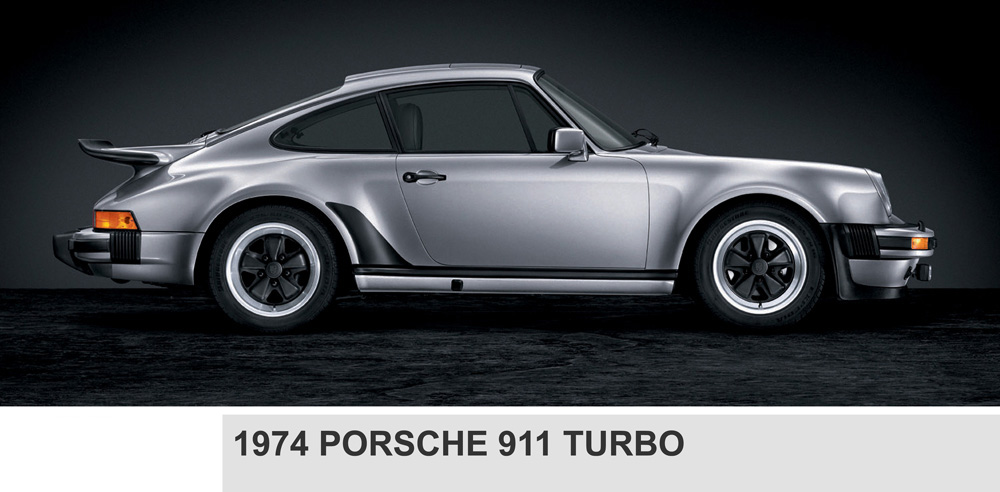
History of success for decades
Turbo engines from Porsche: performing under pressure
Turbo technology is Porsche technology. Further development of the 911 Carrera engines into the new engines with turbocharging was a logical next step. Over decades, Porsche had cultivated the turbocharged engine to offer its unique spread between power and efficiency that was unattainable in conventional naturally-aspirated engines. The original Turbo engine of 1974, which had a power output of 260 hp and a combined fuel consumption of 20.9 litres of super petrol per 100 km, has advanced to today’s engine in the 911 Carrera, which outputs 370 hp and has an NEDC fuel consumption of just 7.4 l/100 km. While having the same displacement as the original engine, the new flat six-cylinder engine’s 42 per cent more power contrasts with its more than doubled fuel economy.
The development of turbocharging began as a classic story of Porsche history: in motor racing. Porsche developed the 917 Spyder for the lucrative American CanAm series, which allowed two-seat race cars with engines of all sizes and types. However, its 4.5-litre twelve cylinder engine with its 560 hp was much less powerful than the huge-displacement engines used by the competition in the USA that produced 750 hp.
Motivated by very promising preliminary studies, Porsche therefore developed forced induction of the twelve-cylinder engine by means of turbochargers. The challenge was to control the pressure build-up of the charging air to make it suitable for high dynamic load and speed changes in the racing engine. Porsche engineers took a new approach to solving this problem. Instead of conventional intake-side control, they developed exhaust-side control of the charge pressure. The bypass valve redirected undesirable overpressure around the turbocharger. From its first race start in 1972, the 917/10 with its initial 850 hp became the dominant race car in the CanAm.
1973: the first 911 Turbo introduces itself
The introduction of turbocharging technology into Porsche production sports cars is legendary. In 1973, the prototype of the 911 Turbo created a sensation at the IAA. One year later it went into production. At that time, the turbocharging technology in the 917/10 had already advanced one development step further. Intercoolers reduced the temperature of the compressed air by as much as 100 degrees Celsius, and cylinder filling was improved which resulted in increased power. In 1977, the 911 Turbo 3.3 benefited from this technology, and its larger engine had now reached the magical power output figure of 300 hp. In 1983, Porsche once again embarked into uncharted territory with the development of the 959 super sports car, designing a 2.8-litre six-cylinder flat engine with sequential turbo charging. The engine had an output of 450 hp that is still a prime example of downsizing today.
After a two-year pause in its production, a new 911 Turbo was offered in 1991. This car had a 3.3-litre engine again – just as the pre-1983 version but with power output of 320 hp and was based on the 911 series with the internal designation 964. Porsche modified this model in 1993. As a 911 Turbo 3.6, it now had a power output of 360 hp. The next generation of the 911 Turbo introduced in 1995 set new standards in sports car engineering. By employing two turbochargers for the first time – one per cylinder bank – the 3.6-litre engine attained a power output of 408 hp.
2000: more power, less fuel consumption
The first generation of the 911 Turbo at the millennium was named one of the “world’s cleanest automobiles” when it was introduced in February 2000. This was enabled by four valve per cylinder technology, water-cooling and above all by the first use of VarioCam Plus. The starting gun for the sixth generation of the 911 Turbo sounded in February 2006. The top model of the 997 model series is the first – and even today the world’s only – production car to have a petrol engine featuring a turbocharger with variable turbine geometry known as a VTG turbocharger.
The 3.8-litre six-cylinder engine followed three years later, which was the first engine in the 35-year history of the 911 Turbo model series that was a completely new design. Thanks to petrol direct injection, improvements to the car’s fuel economy of up to 16 per cent assured it a supreme position in the market segment. The new top model only consumed between 11.2 and 11.5 l/100 km, depending on the specific vehicle configuration. Unlike the general practice in this market segment, the Porsche 911 Turbo managed to remain below the fuel economy limit of the Gas Guzzlers Tax – a special tax for gas guzzling cars in the USA. In the changeover to the new generation of the 911 Turbo, Porsche improved fuel economy an additional 16 per cent and increased engine power by as much as 30 hp (22 kW).
Now the 911 Carrera is benefiting from this technology and the turbocharging expertise that has been built up over decades. Its engine is the first of a new generation of Porsche engines.
For full specification please click here > 2016 Porsche 911 Specification
For more on Porsche History please click here > Porsche Heritage and Historical Models

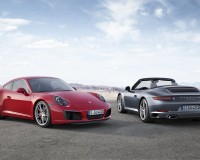
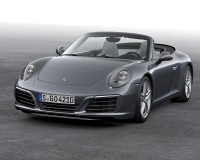
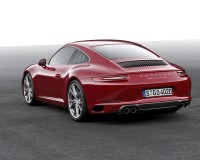
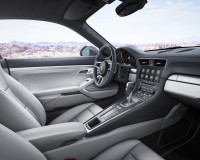
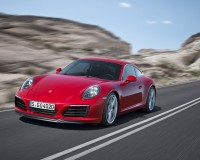
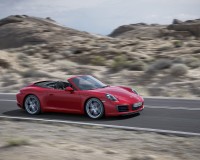

You must be logged in to post a comment.